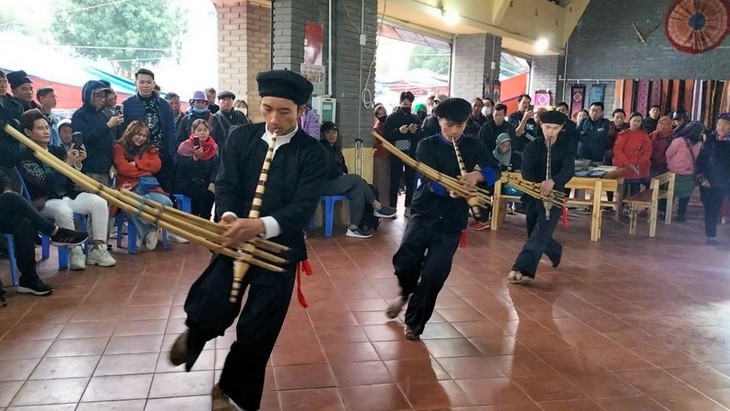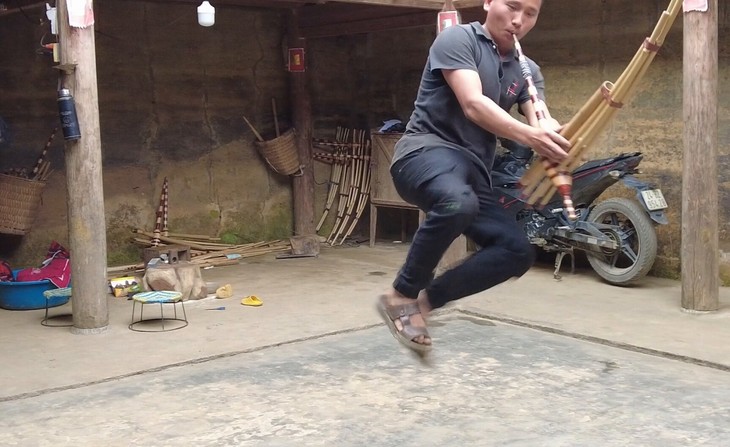(VOVWORLD) -Bac Ha and Si Ma Cai district of Lao Cai province are home to several ethnic groups, principally the Mong, whose festivals, folk songs, and folk dances are unique and closely linked with their spiritual life.
 Hong Mi Club members performing Khen dance to serve visitors at Bac Ha village fair (Photo credit: Giang A Hai, head of Hong Mi Club) Hong Mi Club members performing Khen dance to serve visitors at Bac Ha village fair (Photo credit: Giang A Hai, head of Hong Mi Club) |
One of the most popular dances of the Mong people is the Khen or pan-pipe dance, which exhibits agility, ingenuity and skill.
Ly Quang Din, Deputy Head of the Section for Ethnic Affairs in Si Ma Cai district, says the pan-pipe dance brings people closer together and creates a happy atmosphere during festivals.
“Khen dancing used to be performed only at funerals but today it is a more generalized community cultural activity. It’s passed down from generation to generation,” said Din.
Khen dance movements are unusual: dancers swing their legs, turn in place, play the Khen pan-pipe, roll to the side, roll back, squat, and walk forward and backward in four directions. At each step forward or backward, one foot touches the heel of the other foot. One basic movement involves stooping, turning one heel in place while moving the other heel in a large circle, and then spiraling inward.
 Artisan Giang A Khai of Sin Chen village in Si Ma Cai performing a Khen martial art (Photo: Giang Seo Pua/VOV4) Artisan Giang A Khai of Sin Chen village in Si Ma Cai performing a Khen martial art (Photo: Giang Seo Pua/VOV4) |
According to Giang A Hai, an officer of the Culture and Information Section of Bac Ha district, it takes time to learn to play the Khen and perform the Khen dance well, adding that it requires a lot of dedication and talent.
“It takes more than a year to learn the basic movements. Performers must be very flexible and skilled and to move gracefully while playing the Khen demands mastery of the instrument,” A Hai told VOV.
During Mong festivals and cultural performances, you’ll often see Khen dancers bouncing, reversing, turning, and playing the Khen while rolling on the ground, creating a very striking dance.
Giang A Hai said, “Performers must be skilled to play the Khen and dance at the same time because the dance involves rotating movements similar to martial arts. Hands and feet and breathing must carefully coordinated. It’s very difficult for a beginner.”
The Mong pan-pipe dance embodies their ethnic history. Through multiple migrations, the Mong have preserved and passed down their Khen songs and dances, perhaps their most valuable cultural asset.
 Hong Mi Club members performing senh tien dance with sticks (Photo credit: Giang A Hai, head of Hong Mi Club) Hong Mi Club members performing senh tien dance with sticks (Photo credit: Giang A Hai, head of Hong Mi Club) |
The senh tien
dance (senh tien are castanets made of strung coins) is another popular Mong dance.
Giang A Hai says the dance originated from the weapons the Mong used in ancient times to fight wild animals and enemies. “The Mong’s weapons included knives, swords, cudgels, and sticks. A full set of weapons consisted of 18 items of which the stick was perhaps the most important. It was combined with martial arts movements and sometimes a secondary weapon,” said A Hai.
In some places the weapons were used to see the souls of the dead off to their ancestors or to accompany community activities. In the senh tien dance, one person holds a stick, another holds a cudgel. If one person strikes, the other person parries the blow. In its martial arts-inspired moves this dance is similar to the pan-pipe dance.
A Hai explained, “The traditional stick is still used in senh tien dancing, but it’s no longer part of a set of weapons.”
Anyone, who wants to, can learn senh tien dancing, whether they’re young or old, male or female, and the dance is very popular among the Mong community in Bac Ha and Si Ma Cai.